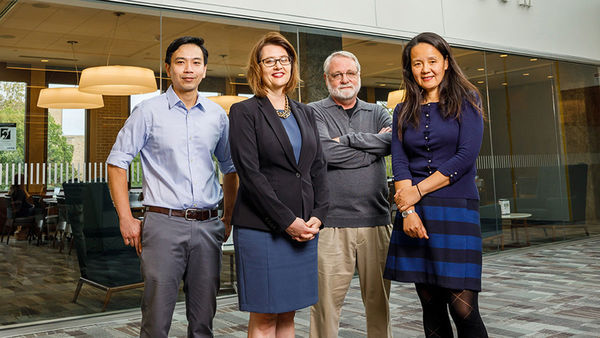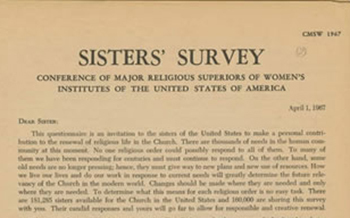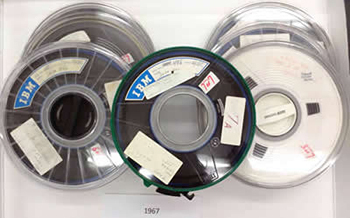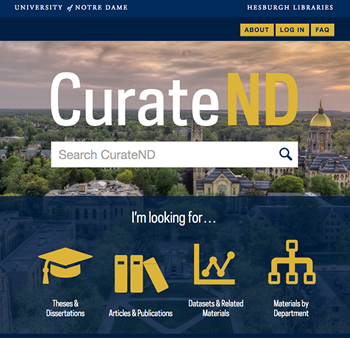
A significant but largely inaccessible survey of more than 130,000 women religious in the late 1960s is now available to scholars around the world, thanks to a digital preservation effort by the University of Notre Dame Archives and Hesburgh Libraries.
University archivists, librarians, subject experts and digital preservation specialists collaborated to migrate The Conference of Major Superiors of Women (CMSW) Sisters’ Survey of 1967 to a digital format that researchers can access online.

The Conference of Major Superiors of Women Sisters’ Survey of 1967
Known as the “Sisters’ Survey,” the dataset was originally generated and maintained on computer tapes as part of a multi-part study conducted by Sister Marie Augusta Neal, a member of the Sisters of Notre Dame de Namur (1921-2004. The data, along with the findings and related records compiled by Sister Neal during her decades of research, came to the University of Notre Dame Archives in 1995 and 1996 as part of the Sister Neal Papers.
While Sister Neal served as director of the Research Committee for the CMSW (later renamed The Leadership Conference of Women Religious), she began a study of the lives and attitudes of women religious in light of the changes brought about by the Second Vatican Council. In 1967, she directed a survey of all members of congregations of women religious. It included 649 questions that were sent to nearly 400 congregations and over 130,000 individual sisters. The Sisters’ Survey holds the coded responses to this survey.
“The University of Notre Dame Archives and the Leadership Conference of Women Religious have long worked together to document and preserve the history of women religious in America,” said Charles Lamb, senior archivist with University Archives. “The release of the Sisters’ Survey of 1967, the pioneering work of Sister Neal, is the latest step in this process. The Archives is honored to have preserved this important digital resource through the decades and proud that Sister Neal’s work will now be openly accessible to a new generation of scholars.”

University Archives traditional and evolving roles
The University Archives has served as the steward of Notre Dame’s history since its founding in 1842. To date, the University Archives encompasses over 45,000 linear feet of archival records, manuscript collections, photographs, audio-visual materials, artifacts and 281 terabytes of born-digital and digitized materials.
Through its rich historical resources, the Archives represents “the institutional memory” of the University and also provides the larger research community with a broad historical focus on the evolution of Notre Dame, its place in higher education, and its place in American history. In addition, the University Archives houses one of the largest and most comprehensive collections on the history of American Catholicism in the country.
As with most industries and areas of specialty, the digital landscape has demanded that archivists adapt and change.
“While print and analog materials remain vital and central to our holdings, the shift toward digital access to these materials is transforming the nature of archival work,” said Angela Fritz, head of University Archives. “As technological changes continue to impact the way archives are used and the nature of our collections, archivists must navigate preserving a broad universe of legacy materials, like the Sisters’ Survey of 1967, as well as an ever-growing universe of born-digital records.”

Archives and libraries align resources to solve preservation challenges
This changing landscape recently prompted the reorganization of the University Archives into the Hesburgh Libraries’ organizational structure. This realignment has invigorated both programs and expanded the University’s ability to leverage expertise and steward resources across traditional and emerging areas of scholarship.
Preservation, discovery and access to growing multi-format collections require that archivists, librarians, scholars and information management experts work in collaboration and across disciplines.
The Sisters’ Survey project is an example of the impact that results from these internal and external partnerships. When Lamb approached Helen Hockx-Yu, program manager for digital product access and dissemination, about the Sisters’ Survey dataset in the University Archives, he knew it had significant research value. It was the Archives and Libraries’ combined expertise, along with the contributions of others that ultimately brought this important dataset to the world.
“The dataset was previously migrated forward to survive media deterioration on two occasions, from tapes to CDs, then to computer hard drives," said Hockx-Yu. “We needed to take additional steps to preserve and provide access. With the help of James Ng, economics and social science data librarian, we were able to clean and reformat the data, migrate it to newer file formats, decode the dataset, and place it into context by cross-referencing the sisters’ responses with the corresponding survey questions."
Jean McManus, librarian for Catholic studies, and Kathleen Cummings, director of the Cushwa Center for the Study of American Catholicism and coordinator of the Conference on the History of Women Religious, helped to further contextualize the data within the larger scope of Catholic history.
“Obviously the Sisters’ Survey is an important a primary source for understanding the history of women religious. The interpretive potential of this dataset, however, extends far beyond that particular topic,” said Cummings. “Having it broadly accessible will contribute to scholarship both on the Catholic Church in the era of Vatican II and on the United States during a particularly momentous decade in its history.”
From there, Notre Dame Archives facilitated proper permissions and rights management to ensure access to the born-digital materials. The dataset and related works now have a new home at CurateND, Notre Dame’s institutional repository. “This project is a perfect illustration of what digital preservation entails and what is required of us to proactively manage and ensure ongoing access to digital collections,” added Hockx-Yu.
Interdisciplinary partnerships ensure sustainable preservation and global access
Digital content has altered the work of archives and libraries and the ways in which they manage their collections — and most preserve and provide access to more resources than ever before.
Preserving digital content is multifaceted and complex. It requires collaborative efforts over time and across specializations in order to succeed and have institutional impact. Facilitating the sustainable preservation and discovery of print, analog and born-digital materials can only be realized through innovative approaches, teamwork and cross-campus partnerships.
“The alignment of the University Archives and Hesburgh Libraries combines our expertise and stewards our resources to help meet one of our greatest challenges — preserving born-digital and digital legacy materials,” said Diane Parr Walker, Edward H. Arnold University Librarian. “Together, we will continue to advance Notre Dame’s mission and help ensure that our unique holdings and world-class collections are available to generations of scholars here on campus and around the world.”
Contact: Angela Fritz, head of Notre Dame Archives, 574-631-9200 or afritz2@nd.edu
Access the Sisters’ Survey of 1967 dataset: https://curate.nd.edu/show/0r967368551
Access the finding aid for the Sr. Neal papers: http://archives.nd.edu/findaids/ead/xml/nea.xml
Originally published by at news.nd.edu on October 06, 2017.